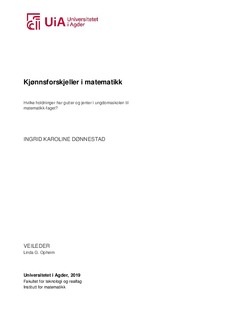| dc.description.abstract | The topicfor thismaster thesis is: “Gender differences in mathematics” andthe research-questionis: “Which attitudes do boys and girls have in lower secondary school towards mathematics?”. In order toanswer this research-question,a triangulation of methods has been used through: interview with sixpupils, survey with 151 respondents and 99 pupils have taken a test. The selection in this study consisted of fiveclasses in 8thgrade, twoclasses in 9thgrade and twoclasses in 10thgrade. Previously, this is a subject that has a lot of research within, but there no clear answers on pupils’attitude towards mathematicsin lower secondary school. Yet, the most important theoretical basis for this study is the report (NOU 2019: 3, 2019) from Stoltenbergutvalget, which contains muchresearch on the subject.In this study, data from ninedifferent classes have been collected and the gendershave been compared through tables made in Excel and SurveyXact.The results in this study shows that there are differenceson how the genders do it on a test. There are differences, but they are insignificant. The big difference between the two gendersare between boys’and girls’ attitudes towards mathematics. Boys appear to be more positive towards mathematics than girls. They tend touse words such as: “Exciting, fun and interesting” to describe the subject, while girls on the other hand tend to use words as: “Challenging and difficult”. The boys state to a greater extent than the girls that they like to work with mathematics and justify this with the description: “It is challenging”. The girls who state that they like to work with mathematics explains it like it is something they know how to do, and that they see that much of the knowledge they learn in mathematics can be used in everyday life. Additionally, there seem to bedifferences inhow the gendersexperience support from home. The boys experience to a great extent that they are being pushed to perform better in mathematics, while girls experience to a great extent that their parents do not say anything at all. Furthermore, there are differences in how the student prefer to work at school. The boys prefer to work in pairs or in groups, while the girls prefer to work in pairs or individually. In addition to this, the results of this study showthat girls generally spend more time doing homework that boys.Overall, it seems as boys are driven by an inner motivation because of their thoughts of mathematics as “fun, exciting and interesting”. Girls on the other hand seem to bedriven by an external motivation because of their greater effort with homework.NOU 2019: 3 (2019). Nye sjanser –bedre læring –Kjønnsforskjeller i skoleprestasjoner og utdanningsløp. Retrieved from: https://www.regjeringen.no/no/dokumenter/nou-2019-3/id2627718/(2.2.19). | nb_NO |

